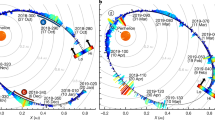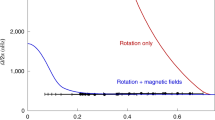Abstract
BECAUSE of its large mean free paths interstellar matter near the solar system has a good chance of reaching within a few astronomical units of the Sun before undergoing collisions with solar protons flying radially outwards from the Sun. The trajectories of interstellar particles crossing the solar system are governed by the gravitational field of the Sun. The particles will be accelerated towards the centre of gravitation, but are also focused at the same time. Because of this effect, the particle density n of interstellar matter within the solar system will be larger then the density n0 at infinity. The function n = n(r,θ) is dependent on the radial distance r from the Sun and the angle θ between the space-vector r and the velocity V0 with which interstellar matter is approaching the solar system. This function n(r,θ) is given by1  where p0 is the impact parameter of the individual trajectory leading to the space-point (r,θ). The space dependent particle velocity v(r) has the form
where p0 is the impact parameter of the individual trajectory leading to the space-point (r,θ). The space dependent particle velocity v(r) has the form  M being the solar mass and γ the gravitational constant. The function H = H (r,θ) and the constant β are given by
M being the solar mass and γ the gravitational constant. The function H = H (r,θ) and the constant β are given by  Because every space-point is hit by two particle trajectories, one corresponding to the angle θ, the other to the angle 360−θ, the total density is given in the form
Because every space-point is hit by two particle trajectories, one corresponding to the angle θ, the other to the angle 360−θ, the total density is given in the form  Near the Sun, the ionizing effect of extreme solar ultraviolet radiation has to be taken into account. I shall assume that all the interstellar matter crossing the surface of a sphere of radius Rc = rE/3 (ref. 1) centred on the Sun, where rE is the Earth's radius, will become ionized. I shall therefore neglect the contributions to the density of trajectories which cross this sphere Rc before reaching an outer space-point. Thus the density profile along the orbit of the Earth shows a semiannual variation, having minima at June 22 and December 22, if we identify v0 and vs as the velocity of the Sun with respect to the local standard of rest (vs = 20 km s−1.)
Near the Sun, the ionizing effect of extreme solar ultraviolet radiation has to be taken into account. I shall assume that all the interstellar matter crossing the surface of a sphere of radius Rc = rE/3 (ref. 1) centred on the Sun, where rE is the Earth's radius, will become ionized. I shall therefore neglect the contributions to the density of trajectories which cross this sphere Rc before reaching an outer space-point. Thus the density profile along the orbit of the Earth shows a semiannual variation, having minima at June 22 and December 22, if we identify v0 and vs as the velocity of the Sun with respect to the local standard of rest (vs = 20 km s−1.)
This is a preview of subscription content, access via your institution
Access options
Subscribe to this journal
Receive 51 print issues and online access
$199.00 per year
only $3.90 per issue
Buy this article
- Purchase on Springer Link
- Instant access to full article PDF
Prices may be subject to local taxes which are calculated during checkout
Similar content being viewed by others
References
Fahr, H. J., Res. Rep. Astro. Inst. Bonn, 68–01 (1968).
Fahr, H. J., Res. Rep. Astro. Inst. Bonn, 68–04 (1968).
Jacchia, L. G., Slowey, J. W., and Campbell, I. G., Smithson. Astrophys. Obs. Spec. Rep., 265 (1968).
Cook, G. E., Plan. Spa. Sci., 15, 627 (1967). Cook, G. E., and Scott, D. W., ibid., 14, 1149 (1966). King-Hele, D. G., Nature, 217, 833 (1968).
Newell, R. E., Nature, 217, 150 (1968).
Author information
Authors and Affiliations
Rights and permissions
About this article
Cite this article
FAHR, H. Charge-transfer Interactions between Solar Wind Protons and Neutral Particles in the Vicinity of the Sun. Nature 219, 473–474 (1968). https://doi.org/10.1038/219473a0
Received:
Issue Date:
DOI: https://doi.org/10.1038/219473a0
This article is cited by
-
In Situ Observations of Interstellar Pickup Ions from 1 au to the Outer Heliosphere
Space Science Reviews (2022)
-
Interstellar Neutrals, Pickup Ions, and Energetic Neutral Atoms Throughout the Heliosphere: Present Theory and Modeling Overview
Space Science Reviews (2022)
-
Charge Transfer Reactions
Space Science Reviews (2010)
Comments
By submitting a comment you agree to abide by our Terms and Community Guidelines. If you find something abusive or that does not comply with our terms or guidelines please flag it as inappropriate.



